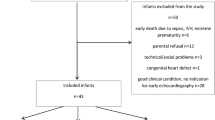Abstract
Blood flow velocities and pulsatory indices in both renal arteries (RAs) and in the internal carotid artery (CAI) were measured by pulsed Doppler ultrasonography in ten preterm infants with patent ductus arteriosus (PDA), before and after surgical ligation. The results obtained in the RAs were compared to those found in a reference group of 22 stable preterm infants. In the RAs the diastolic steal volume of the PDA led to a marked decrease in diastolic blood flow velocity (range 3 to-23 cm/s). Seven infants showed retrograde diastolic flow, whereas only three infants had these flow patterns in the CAI. In the RAs, the peak systolic blood flow velocities (range 56 to 135 cm/s) exceeded the values found in the reference group by 85% on average. The pulsatility indices reached values of above 1,00. In spite of the increase in systolic flow velocities before surgery, the time mean of maximum velocities was significantly lower than those measured after surgery and in the reference group. After PDA ligation, blood flow velocities normalized. The present study shows that a large PDA may induce abnormal flow patterns even in the RAs. These flow patterns may predispose to renal hypoperfusion and subsequent impairment of renal function.
Similar content being viewed by others
Abbreviations
- CAI:
-
internal carotid artery
- NFC:
-
necrotizing enterocolitis
- PDA:
-
patent ductus arteriosus
- PI:
-
pulsatility index
- RA:
-
renal artery
- Vd:
-
end-diastolic velocity
- Vmax :
-
time mean of maximum velocity
- Vs:
-
peak systolic velocity
References
Bömelburg T, Jorch G (1988) Investigation of renal artery blood flow velocity in preterm and term neonates by pulsed Doppler ultrasonography. Eur J Pediatr 147:283–287
Cassels DE (1973) The ductus arteriosus. Thomas, Springfield, Ill, pp 143–160
Deeg KH, Gerstner R, Bundscherer F, Harai G, Singer H, Gutheil H (1987) Dopplersonographischer Nachweis erniedrigter Flußgeschwindigkeiten im Truncus Coeliacus beim offenen Ductus Arteriosus Botalli des Frühgeborenen im Vergleich zu einer gesunden Kontrollgruppe. Monatsschr Kinderheilkd 135:24–29
Eldridge MW, Alverson DC, Howard EA, Berman W (1983) Pulsed Doppler ultrasound: principles and instrumentation. In: Berman W (ed) Pulsed Doppler ultrasound in clinical pediatrics. Futura, Mount Kisco, New York, pp 5–12
Ellison P, Eichorst D, Rouse M, Heimler R, Denny J (1983) Changes in cerebral hemodynamics in preterm infants with and without patent ductus arteriosus. Acta Paediatr Scand 311:23–27
Evans DH (1985) On the measurement of the mean velocity of blood flow over the cardiac cycle using Doppler ultrasound. Ultrasound Med Biol 11:735–739
Gersony WM (1986) Patent ductus arteriosus in the neonate. In: Pediatric clinics of North America, vol 33: the newborn II. Saunders, Philadelphia London Toronto, pp 545–560
Jorch G (1987) Transfontanellare Dopplersonographie. Thieme, Stuttgart New York
Kittermann J (1975) Effects of intestinal ischemia. In: Moore TD (ed) Necrotizing enterocolitis in the newborn. Report of the 68th Ross Conference on Pediatric Research. Ross Laboratories, Columbus, Ohio, pp 38–40
Lipman B, Serwer GA, Brazy JE (1982) Abnormal cerebral hemodynamics in preterm infants with patent ductus arteriosus. Pediatries 69:778–781
Martin CG, Snider R, Katz SM, Peabody JL, Brady JP (1982) Abnormal cerebral blood flow patterns in preterm infants with a large patent ductus arteriosus. J Pediatr 101:587–593
Rudolph AM, Scarpelli EM, Golinko RJ, Gootman NL (1964) Hemodynamic basis for clinical manifestations of patent ductus arteriosus. Am Heart J 68:447–458
Serwer GA (1983) Detection and quantitation of ductus arteriosus flow using continuous wave Doppler ultrasonography. Pediatr Cardiol 4:53–59
Serwer GA, Armstrong BE, Anderson PAW (1980) Noninvasive detection of retrograde descending aortic flow in infants using continuous wave Doppler ultrasonography. J Pediatr 97:394–400
Spach MS, Serwer GA, Anderson PAW, Canent RV, Levin AR (1980) Pusatile aortopulmonary pressure-flow dynamics of patent ductus arteriosus in patients with various hemodynamic states. Circulation 61:110–122
Wilcox WD, Carrigan TA, Dooley KJ, Giddens DP, Dykes FD, Lazzara A, Ray JL, Ahmann PA (1983) Range-gated pulsed Doppler ultrasonographic evaluation of carotid arterial blood flow in small preterm infants with patent ductus arteriosus. J Pediatr 102:294–298
Author information
Authors and Affiliations
Rights and permissions
About this article
Cite this article
Bömelburg, T., Jorch, G. Abnormal blood flow patterns in renal arteries of small preterm infants with patent ductus arteriosus detected by Doppler ultrasonography. Eur J Pediatr 148, 660–664 (1989). https://doi.org/10.1007/BF00441528
Received:
Accepted:
Issue Date:
DOI: https://doi.org/10.1007/BF00441528




